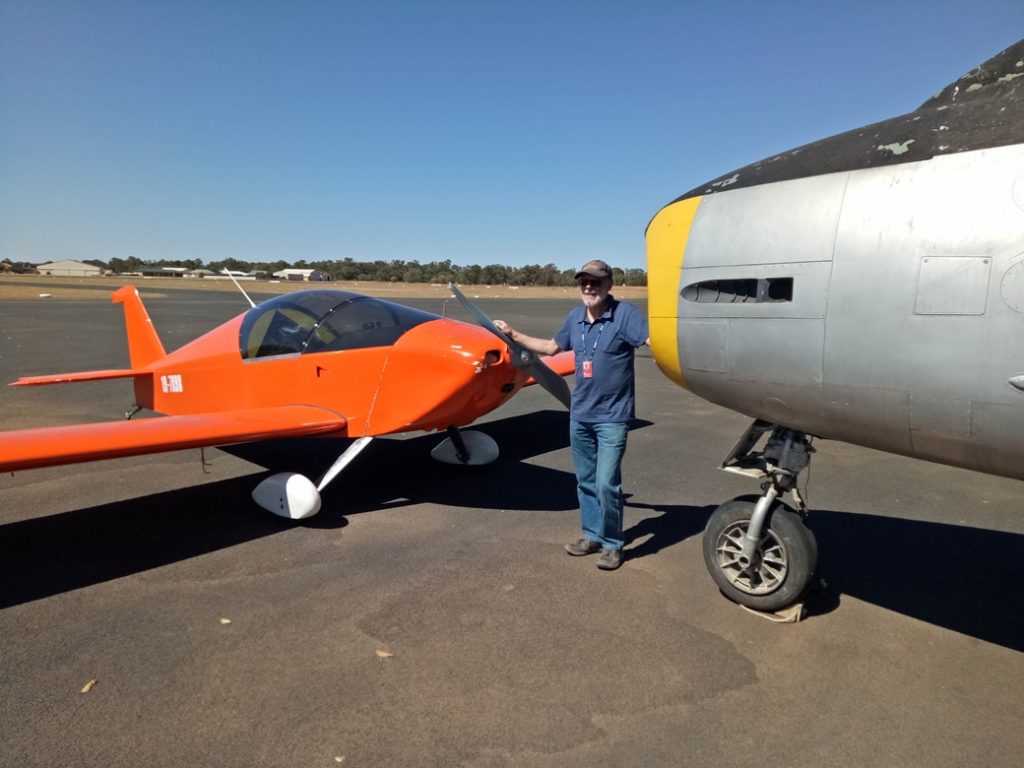Well, maybe I do sometimes, but I don’t want to give up that easily, so last time I wanted to fly up to Rockhampton I decided to take the Sonex again, but things don’t always go quite to plan. My sister, Jen had booked a 10 day outback tour and while Mum, at 95, is pretty capable of looking after herself she is a bit limited. She no longer drives although she does have a little electric buggy to get around. Still, the company of her favourite (only) son would be welcome. It’s about 900+ nautical miles to Rocky, so about 8 flying hours plus ground time for refueling stops making for a pretty solid flying day. My previous trips were in winter and I had never been able to make the distance in one day, even with good flying conditions, but with the longer days in mid October I reckoned I could do the whole thing in a day easily. In theory I could do the trip with just three stops but with no fuel available at Hedlow, my destination airfield, I was going to have to do an extra stop short of the destination to top up. I wanted to arrive on the 16th to 17th of October. The weather for most of the trip looked best on the 17th except for forecast thunderstorms south of Rocky late in the day. It looked like the 16th was the best option.

Kyneton to Temora
I had checked out the Sonex the previous day so other than packing tools and luggage and filling a fuel container with 12 litres of peace-of-mind fuel it was ready to go. I texted Sue my departure and intended arrival time and managed to get away by 7:30 flying into light headwinds and under a complete overcast which was forecast to clear as I traveled north, but I wasn’t quite out of the woods. After only 30 NM I was unsuccessfully dodging light rain squalls and looking for the lighter sky beyond but at the Waranga Basin I was able to climb to 5500 feet and gps speed was 125 to 130 knots. It wasn’t the last of the rain but probably the worst of it.
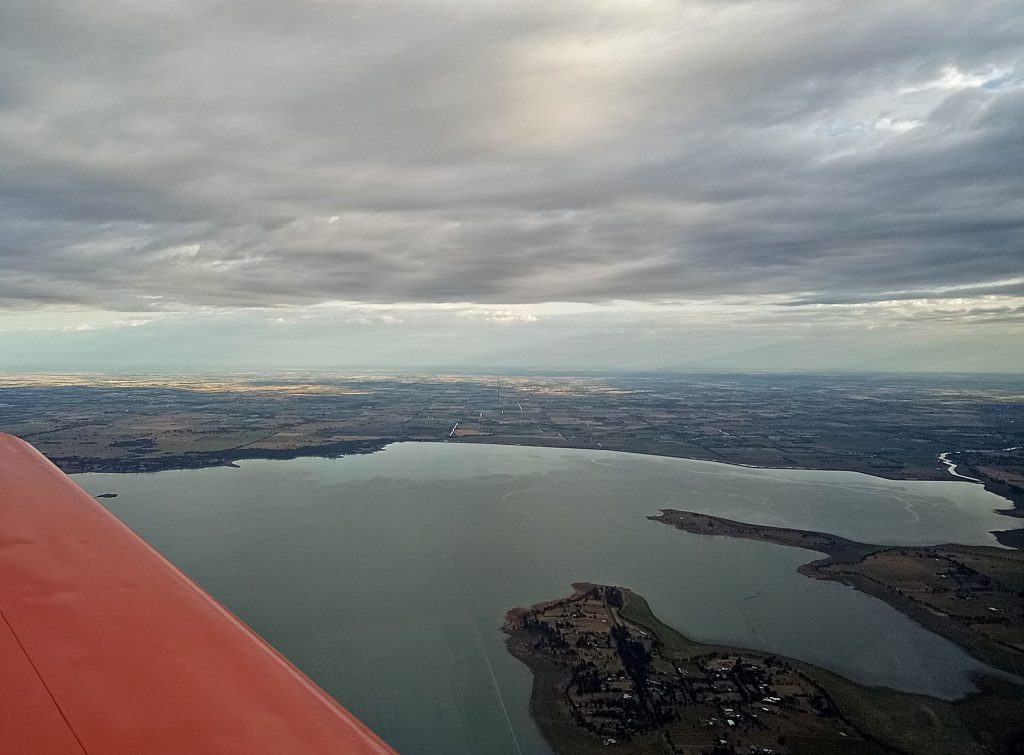
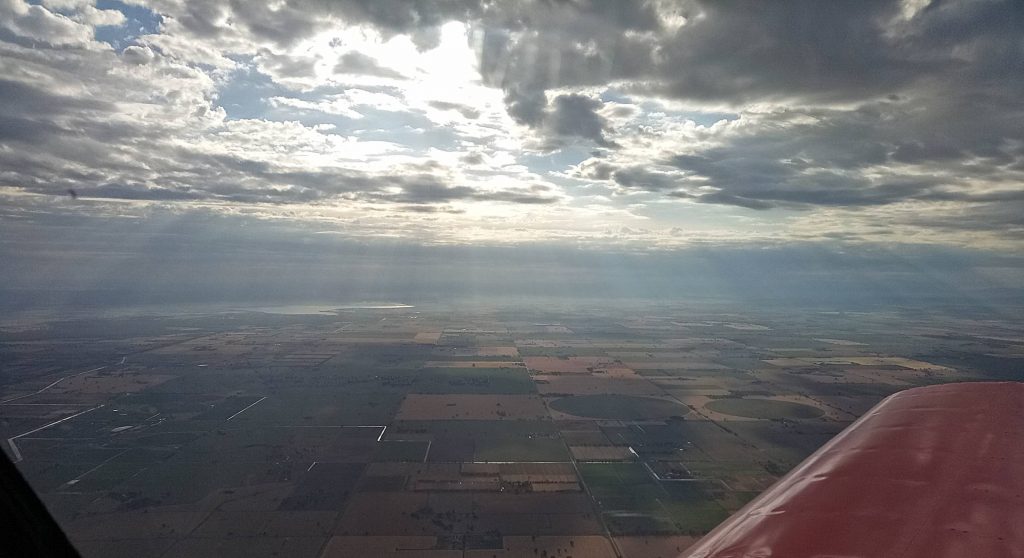
Distance Time Av. speed Fuel used Fuel rate
225 NM 1.94 hrs 116 knots 38.86 litres 20.03 l/hr
Temora to Narrabri
I had planned to track direct from Temora to Narrabri, but in my concern for the weather I failed to notice that a restricted area was about to become active on my path. In fact the restricted area is in two layers and only the upper one was closed but while flying the Sonex and glancing at the iPad I didn’t notice that major detail. In the mean time I dodged more rain squalls until the weather finally cleared north of Parkes where I also noticed the active restricted area ahead. I hurriedly added Gilgandra to my flight plan to divert around the western edge of the zone and changed course for the new waypoint. After only a minute or two on the new course I noticed a tiny 1 mile radius restricted zone only 2 miles ahead. Bloody hell, I was about to fly directly over the top of the Parkes telescope. Another wobble in my course and I was on my way into what was to gradually become a sunny but hazy sky.
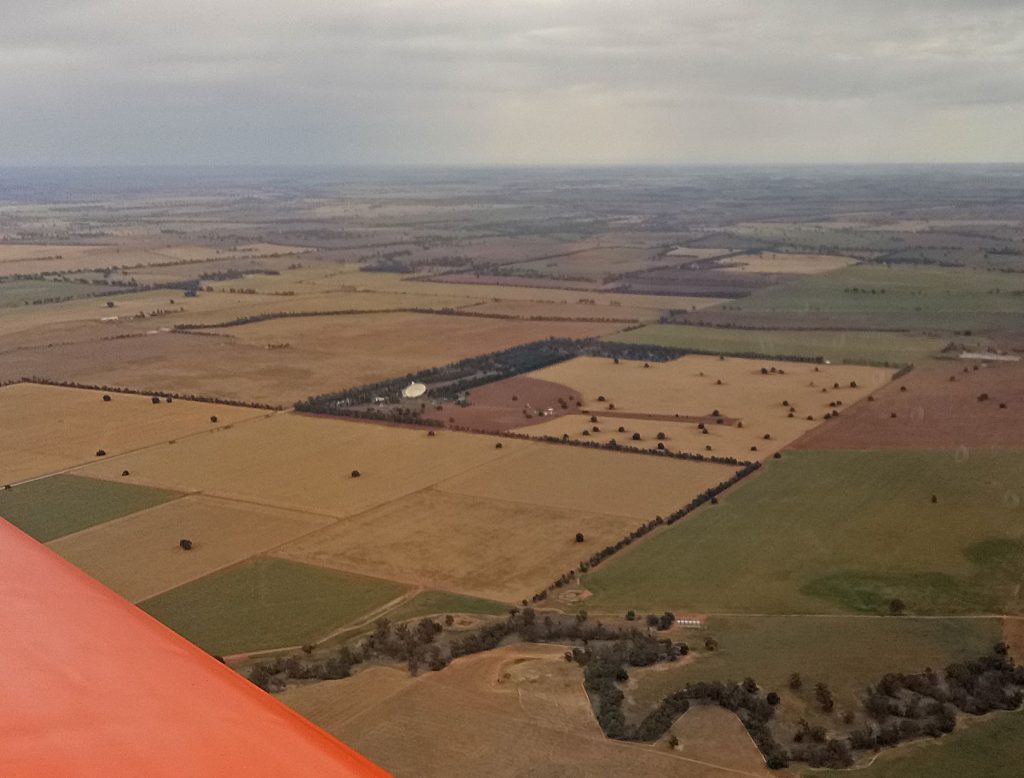
After turning back towards Narrabri at Gilgandra I was able to climb to 7500 to cross the Warrumbungles, home of the Siding Springs astronomical observatory, and the forested area to the north.
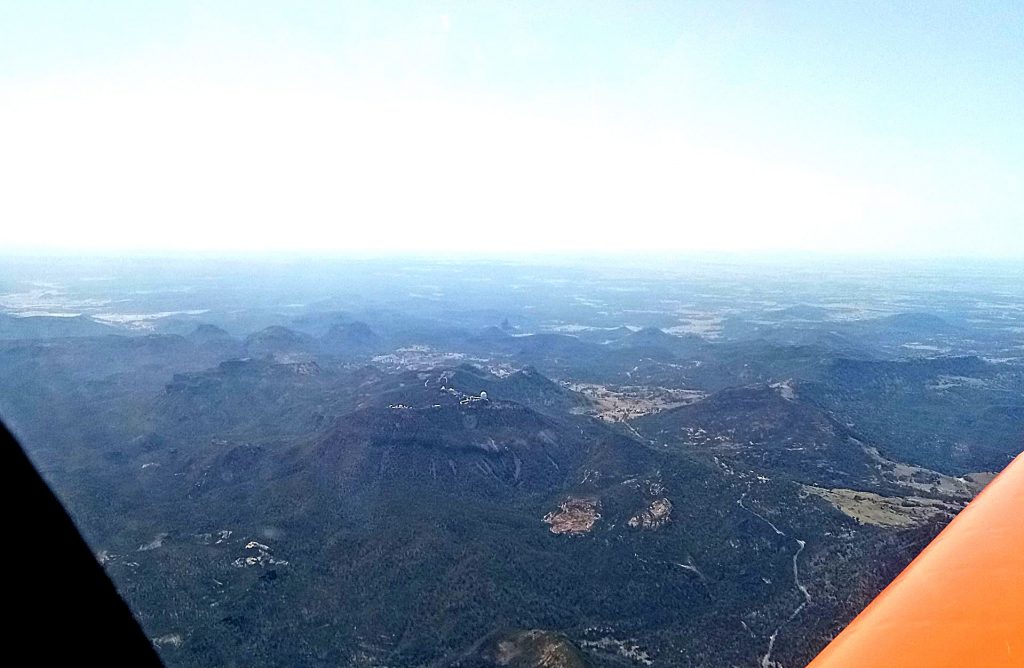
I did a long 20 mile descent to Narrabri, careful to keep my speed down as it became steadily hotter and rougher, followed by a bouncing circuit and a blast of hot air through the vents. I peeled off a top layer of clothing, not to be needed until well into my return flight, refueled and couldn’t wait to get back into cooler air. The place was an oven.
Distance Time Av. speed Fuel used Fuel rate
276 NM 2.36 hrs 117 knots 46.24 litres 19.5 l/hr
Narrabri to Roma
I climbed straight to 6500 and a bit later to 8500 and let the distance roll by. The whole of northern New South Wales and a large part of Queensland are suffering a severe drought and it really shows. Quite large towns like Dubbo, population 39,000, face the prospect of running out of water. From my perspective the land looked almost grey and the horizon disappeared in the haze.
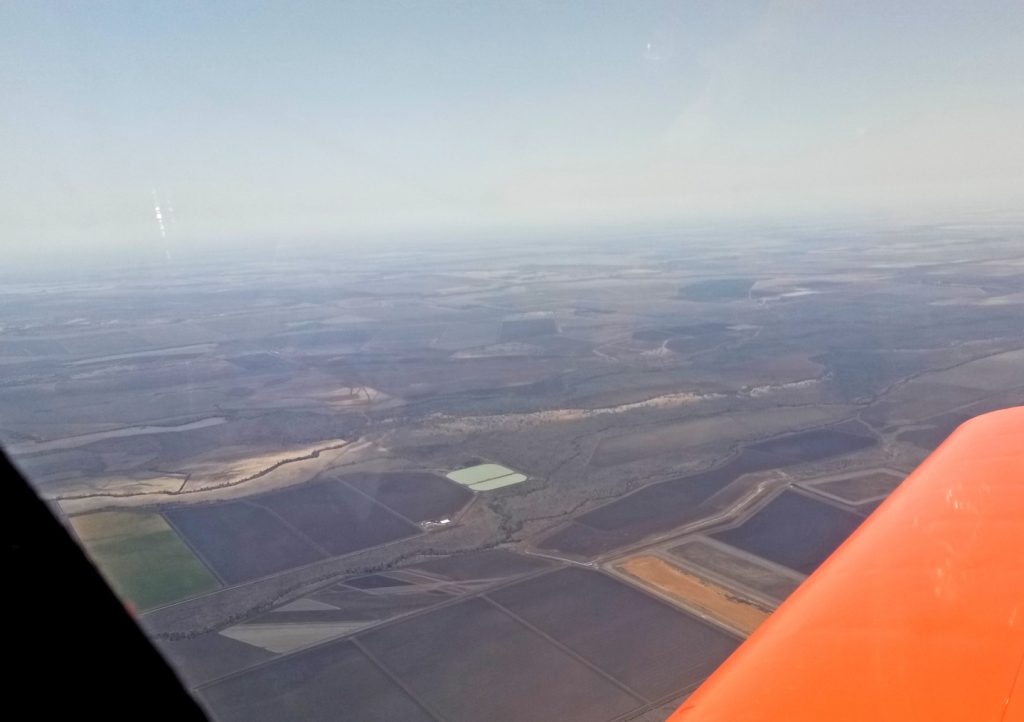
Again I did a long descent taking care to keep the speed down and again I was greeted by blistering temperatures at ground level. I refueled and then phoned the security guy for a gate code so I could visit the toilet. He wouldn’t give me the code until he had come to inspect my ASIC (Airport Security Identification Card). What do you do if you haven’t got an ASIC? Crap on the tarmac I suppose.
Distance Time Av. speed Fuel used Fuel rate
233 NM 2.10 hrs 111 knots 40.62 litres 19.34 l/hr
Roma to Thangool
I had carefully placed my iPad in the shade when I arrived at Roma but it overheated anyway. I set course for Thangool and climbed to 7500 as quickly as power and temperatures would allow while holding the iPad in the blast of the cabin intake and it eventually came back to life while I flew in a haze that totally masked the horizon. At Thangool the wind fairly evenly split the two runways but appeared to slightly favour the dirt strip. I must have been getting a bit tired by that stage because the landing felt fast and I used up most of the 900 metre runway length, but I was down safely with only 85 NM to go and plenty of time only to find that the card reader wouldn’t recognize my debit card. Damn! After a couple of phone calls a young guy from the local supplier turned up with a card that the pump could read so I got my fuel but his portable card reader couldn’t log on and I didn’t have enough cash. Eventually I just wrote out my card details on a slip of paper and hoped for the best, but it held me up for about an hour. While he was stuffing around a cow cockey (rancher to you) turned up from a place near Banana, about two hours drive away. Yes, that really is a place. It’s in the Banana Shire. You can’t miss it. He wanted to fill 2 x 200 litre drums for refueling their helicopter. They use Robinson R22s for cattle mustering. The card reader wouldn’t read his card either but I left them to sort things out.
Distance Time Av. speed Fuel used Fuel rate
157 NM 1.40 hrs 112 knots 26.4 litres 18.86 l/hr
Thangool to Hedlow
I could have easily reached Hedlow without the refueling stop at Thangool, but unfortunately fuel isn’t available at Hedlow, hence the stop. This last part of the trip can be quite spectacular in clear weather. In haze and cloud, not so much, and the closer I got to the coast the cloudier and hazier it got. Here’s the Callide B power station and its associated coal mine. Conservative politicians are fond of stating that wind powered generators are an eye-sore. I wonder what they would think of this.
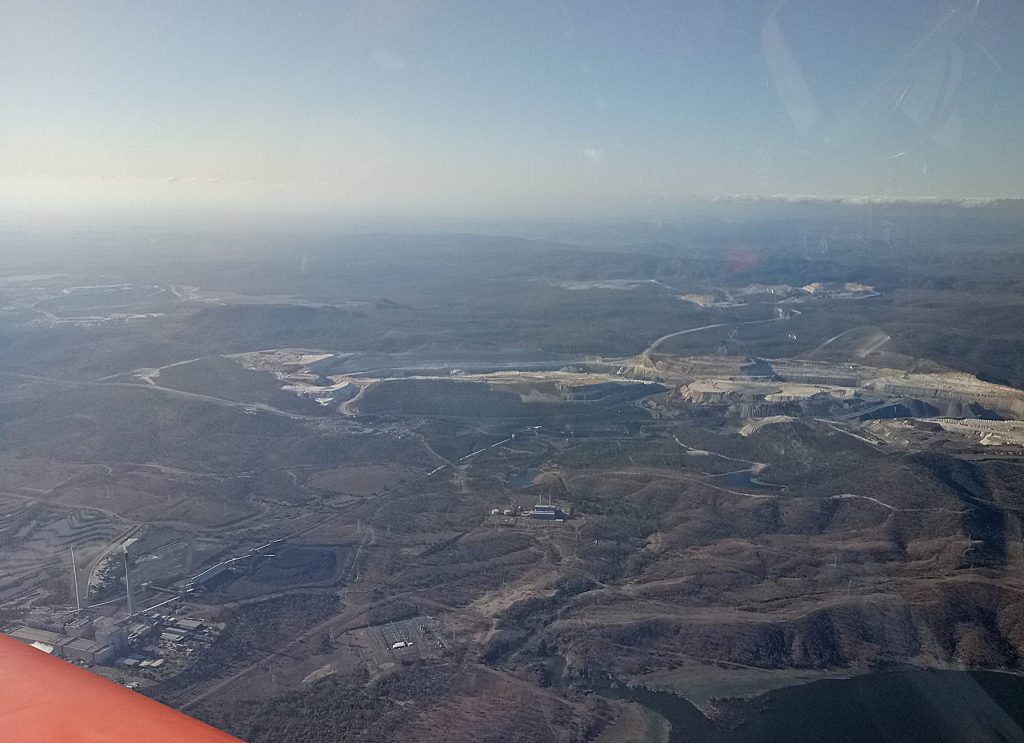
Here is part of the range I crossed to the coast. I must confess that the view wasn’t quite this clear. I have sharpened the image somewhat.
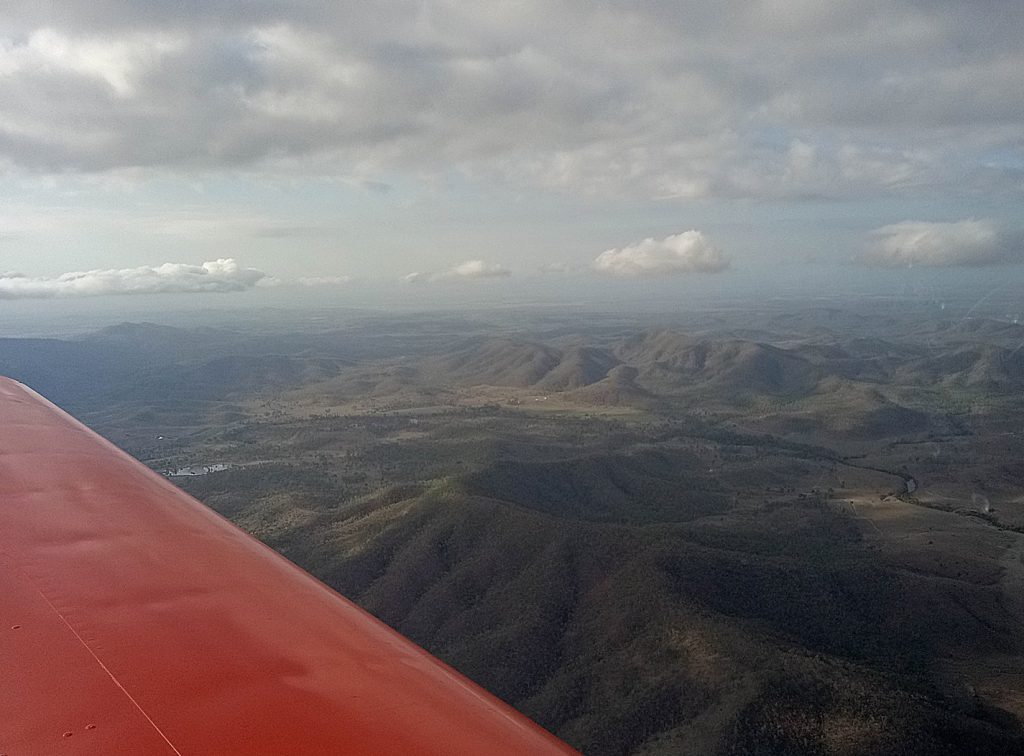
One problem with the haze was that it made judging where the clouds started and finished difficult. At one stage I suddenly found myself flying in cloud and had to do a rapid descent. Hedlow has a huge rock, Mount Iron Pot, standing 500 feet high within the circuit, but in the haze I couldn’t see it until I was within 5 miles, but I was safely down and the Sonex hangared.
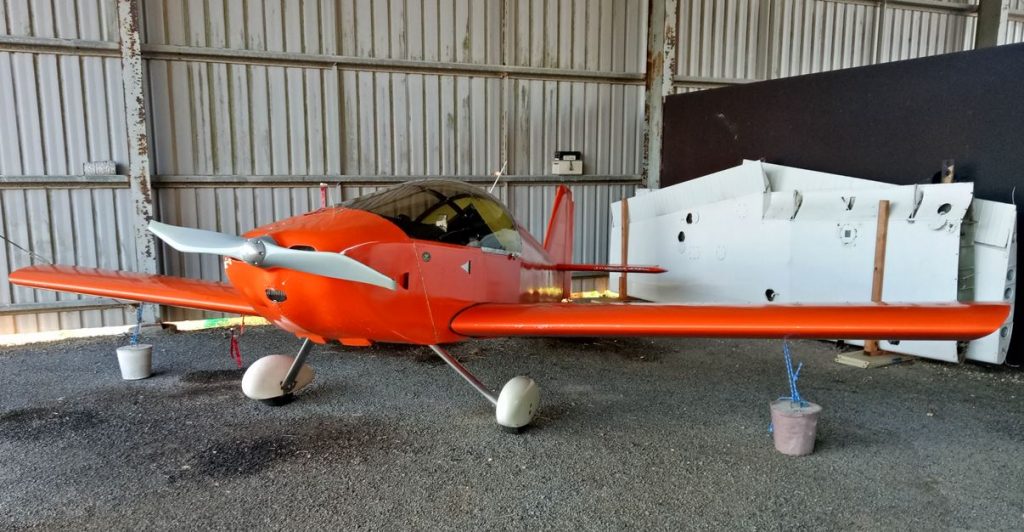
The Sonex took a bit of a beating from the rain. The cowl wasn’t in great condition but the rain of the prop blasted a fair bit of paint off and the prop lost all its top paint coat from the leading edge.
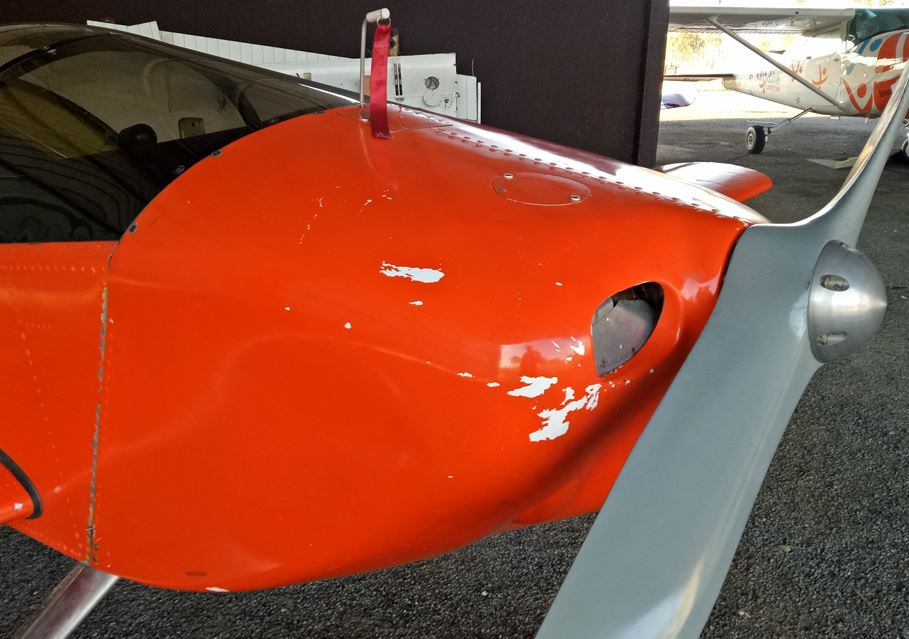
I topped up the tank with 12 litres of Avgas that I was carrying and during the week I visited the Fort Knox-like security of Rockhampton airport to refill my container and added a further 7 litres.
Distance Time Av. speed Fuel used Fuel rate
85 NM 0.84 hrs 101 knots 19.0 litres 22.62 l/hr
Rockhampton
I spent 11 days in Rocky during which I did all the mundane things like walking dogs, cooking meals, doing a couple of minor maintenance jobs and generally avoiding work. On the first Monday, Mum and I went to “Morning Melodies” at the Pilbeam Theatre. Last time I went to one of these shows it was terrific. This time it was “Tenori”, three operatic tenors singing mostly popular songs. I wasn’t optimistic and my expectations were fully met. They all had great voices but were miked and amplified so loud that Mum didn’t need her hearing aids. They actually apologized before singing a few operatic songs. Good grief! I was not familiar with “The slaves chorus” from Nabucco, but it sounded beautiful and they did a good version of the famous duet from Bizet’s “Pearl Fishers”. That’s written for a tenor and baritone so somebody’s balls must have dropped. I have heard “Nessun Dorma” enough for several lifetimes, then it was back to the pop. Even songs that were intended to be sung solo they did as a sort of tag team. Maybe nobody could be bothered learning all the words. I have always hated “My Way”, the story of an arrogant prick, but of course that was included. I left feeling all schmaltzed out.
The home run – Hedlow to Chinchilla
I had picked Jen up at Rockhampton airport on Sunday and she returned the favour by giving me a lift to Hedlow early on Monday. Doing the daily I noticed that the tail wheel tyre seemed a bit low so pumped it up before heading off at about 7:30. It would have been nice to leave a bit earlier as sunrise was 5:33 but I couldn’t really ask Jen to get up at 4:30. By 7:30 it is already getting hot. The rest of eastern Australia changes to summer time but apparently Queenslanders prefer to get up to blazing heat and have an early sudden darkness. Rockhampton is right on the Tropic of Capricorn so sunset is very sudden in summer. I assume sunrise is too but I never see it.
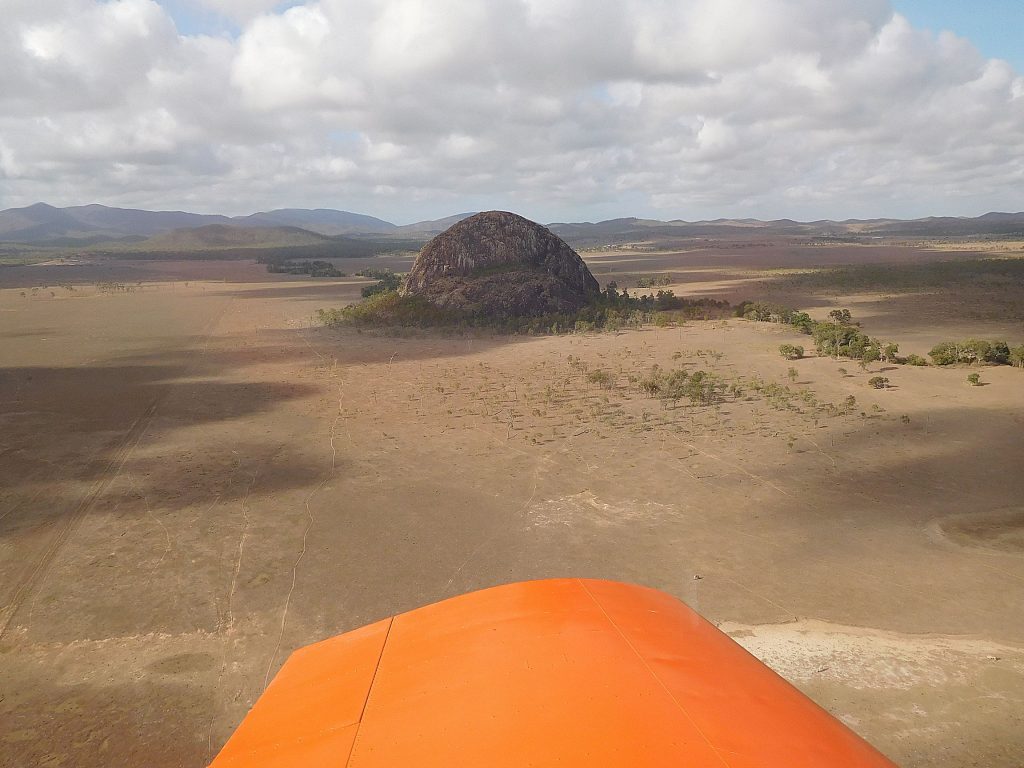
Clouds were already forming over the coast which was going to prevent me from flying high in a region where height was desirable for safety so instead I planned a route around the north of Rockhampton’s controlled airspace which necessitated doing the first leg at below 1000 ft and weaving between a few hills. Other than the customary head wind, conditions were good.
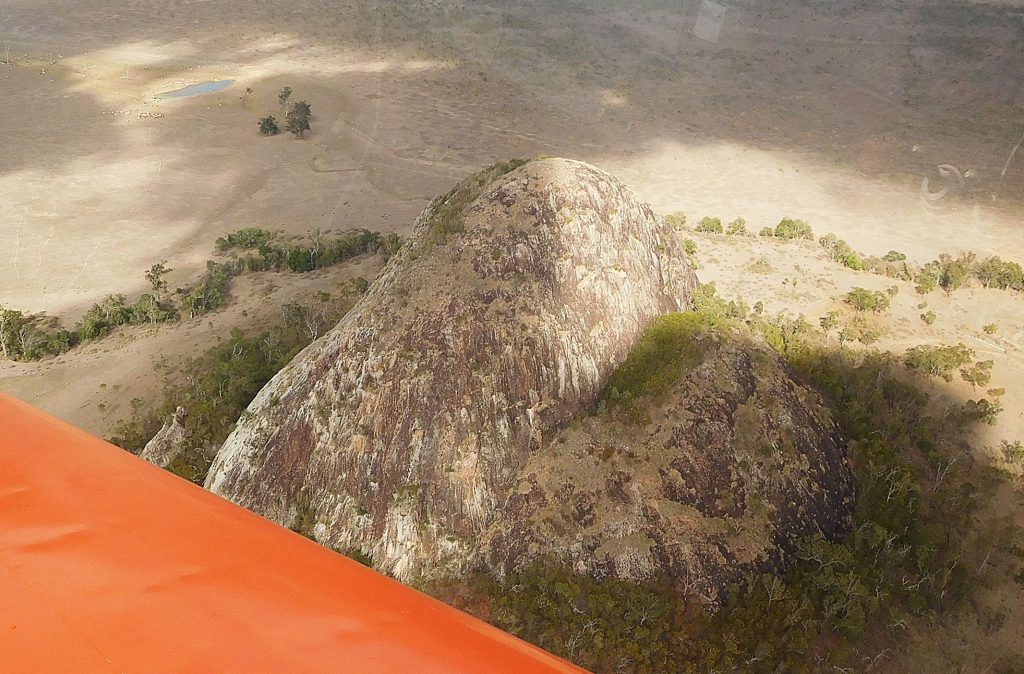
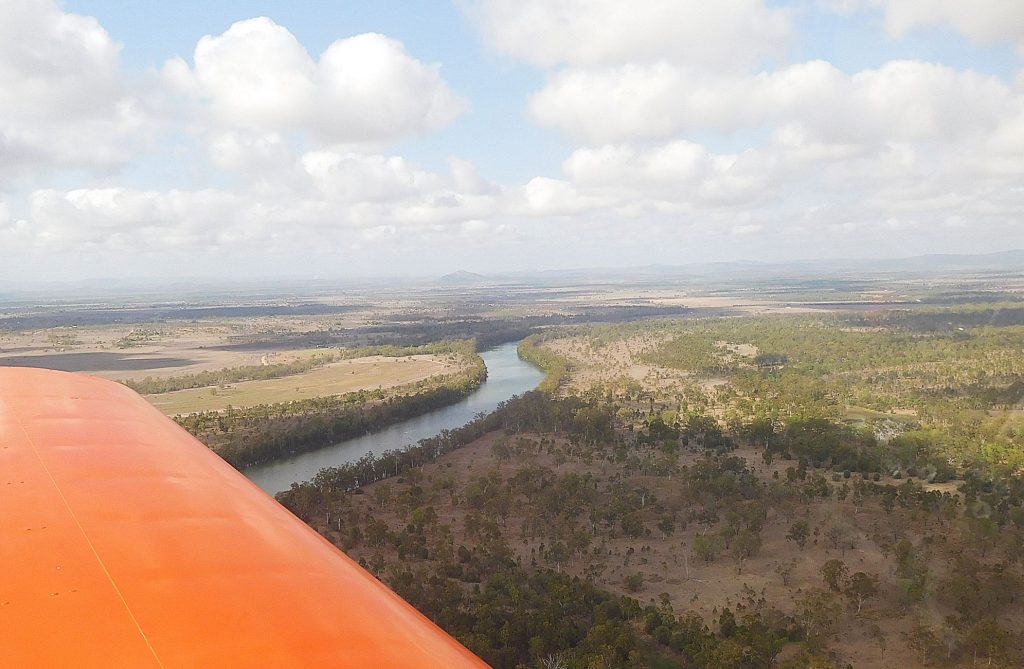
The first turning point was Ridgelands, barely distinguishable from the surrounding country but after only 15NM I was able to climb to 4500 ft through the scattered cloud. My next turning point was Gogango (really) where I climbed to 5500 ft for the long leg to Chinchilla. It was still smooth conditions but ground speed gradually dropped as the wind increased. It was pretty bumpy when I descended to land. Little gardener’s side note: From the air there was lots of purple in Chinchilla due to the large number of Jacaranda trees in flower. It was about 9:30 so not really hot yet but hot enough.
Distance Time Av. speed Fuel used Fuel rate
234 NM 1.99 hrs 118 knots 41.05 litres 20.63 l/hr
Chinchilla to Narrabri
I flew at 7500 for the first hour and then turned a bit of a corner and went to 8500. My OzRunways navigation software on the iPad was showing lots of aircraft activity to the east of Narrabri and I correctly guessed fire fighting. The closer I got to Narrabri the hazier it became with smoke from the fires and it was also getting bumpy. It was really bumpy as I did a long slow descent and gloomy enough that I couldn’t see the airfield until I was within about 6 miles. I refueled and noticed that the tail wheel tire that I had pumped up that morning was obviously low so I pulled the Sonex into a parking area and changed the tube, a miserable experience as about a thousand flies descended on me. I plastered myself with insect repellant but that didn’t stop them from trying. It was hot, I was sweating and probably about the only source of moisture around. There is a little air conditioned terminal building but I don’t suppose they would have approved of me moving in there with my tools but I did go there to cool down after.
Distance Time Av. speed Fuel used Fuel rate
217 NM 2.03 hrs 107 knots 38.61 litres 19.02 l/hr
Narrabri to Temora via Narromine
I gradually left the smoke behind but even climbing to 8500 ft wasn’t enough to leave the thermals behind. After 50 minutes of bouncing around the sky I decided it wasn’t much fun and would rather be on the ground so diverted to Narromine where there is good accommodation in the camp ground attached to the airfield. In retrospect my chosen route over a large forested area was probably a bad choice because the air smoothed out a bit once I was over open country again, but my change of plan was rewarded when I circled over Narromine and saw a shiny silver aircraft with swept wings parked there.
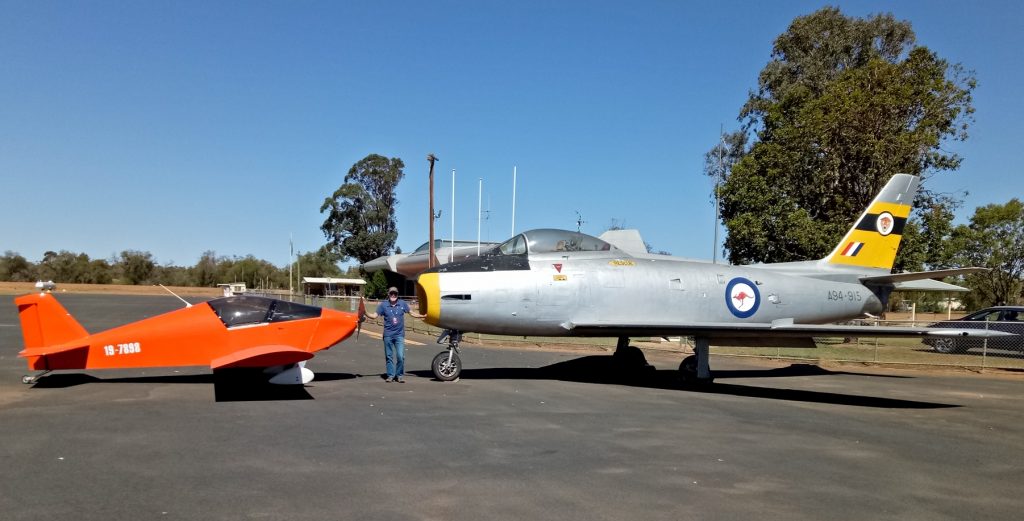
The aircraft is not an F86 but a CA-27, an Australian built version of the Sabre with larger air intake, more powerful Rolls Royce Avon engine, greater fuel capacity and is armed with two 30mm cannon instead of the six ½” machine guns. Not only that, but my father flew this particular aircraft. That isn’t actually too unlikely because the RAAF (Royal Australian Air Force) only had 112 Sabres and in the 1950s Dad was the test pilot for 1AD, the aircraft development unit. He flew the acceptance tests on many of the new aircraft as they were delivered to the air force. Here is the best story I remember about my father flying:
The early jet engines had a few problems. Some high altitude maneuvers and throttle settings would cause the engine to flame out. Part of Dad’s job was to do test flights for ARDU (Aircraft Research and Development Unit) while they investigated the flame-out problem. They would supply a list of maneuvers to fly and he would cope with as many as four flame-outs and relights in a flight. Imagine having your engine cut out and having to restart it four times in a flight and you get the picture. To save battery power for the relight he would switch out the circuit breakers for any non-essential equipment but there was one breaker that was difficult to reach and it happened on one flight that particular circuit was drawing so much current that it flattened the battery so he was unable to relight. He was over 70 nautical miles from base but fortunately at 48,000 feet. If you do the maths you will see that it is just within glide range. He flew back to Laverton and did a dead stick landing, saving the aircraft and himself. Ejecting was an option of course but the early ejection seats carried considerable risk and a couple of pilots were killed attempting to eject.
I tied down for the night and booked one of the motel-style rooms in the campground, a little disappointed not to make it home in one day, but 5 ½ hours flying is enough for one day. Near 6PM I wandered into town passing the local golf club.
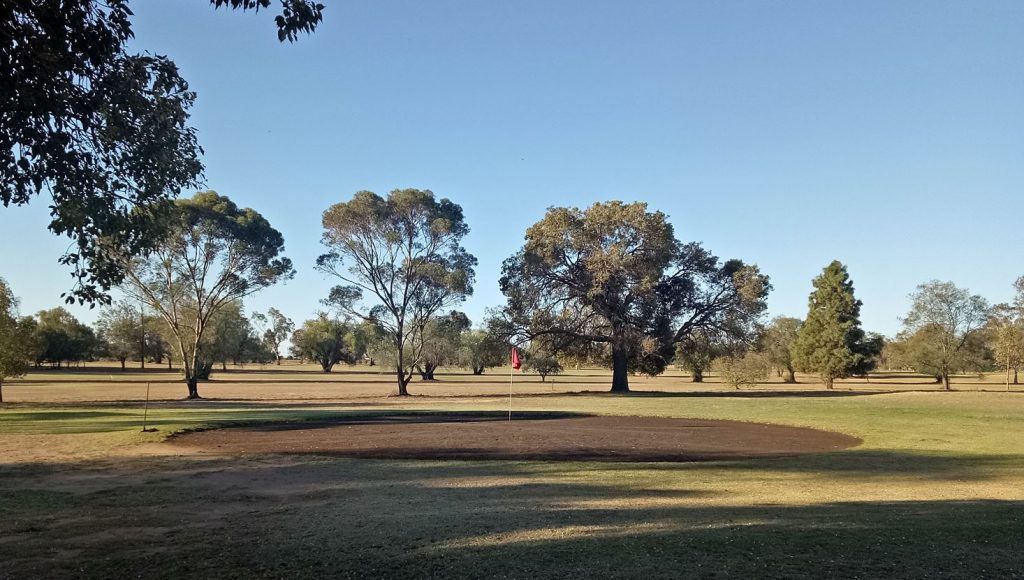
It’s not too uncommon for the golf clubs in small towns, especially ones in dry regions, to have oiled sand scrapes instead of greens. The nearest restaurant was the local services club where I had a cheap “seniors” meal and a welcome beer. As a non club person I had to get a temporary membership by feeding my drivers license into a card reader which printed out my temporary membership card. I am now known as PETHS ANSON in the Narromine services club.
With sunrise at 6AM I set my alarm for 5, hoping to get away early, but something went wrong and I woke at 6:15, not quite to plan. I topped up the tank with 5 litres of avgas from my container and got away at 7:15 into what from the ground looked like a clear sky but as I climbed out I flew into haze. The wind was now from the north and blowing all the smoke from the fires to greet me again.
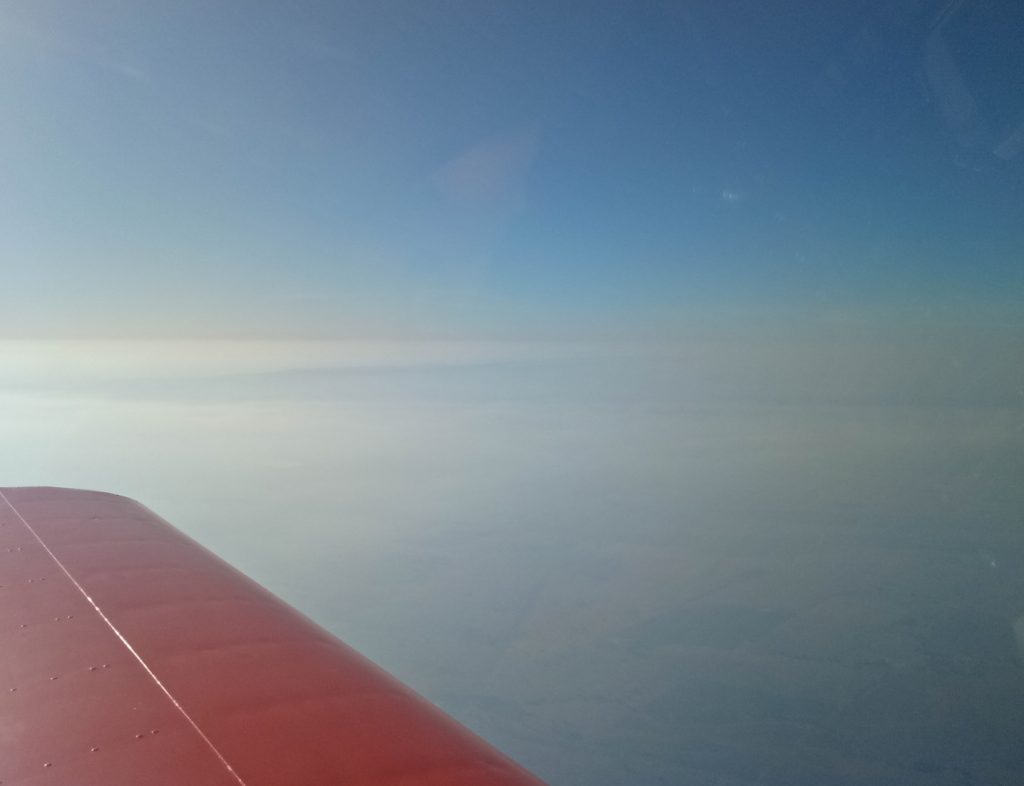
Had to go to 6500 to be sure I could see a reasonable horizontal distance, but other than that, beautiful flying conditions and about 135 knots gps speed. Only a little over an hour for the 137 NM to Temora and refueled for the last leg home.
Distance Time Av. speed Fuel used Fuel rate
279 NM 2.42 hrs 115 knots 44.72 litres 18.48 l/hr
Temora to Kyneton
Headed off at 4500ft but gps speed gradually dropped so checked Windy TV on my iPad and it looked like the wind lower would be more favourable so descended to 2500 and gained at least 5 knots and a pretty quick trip home.
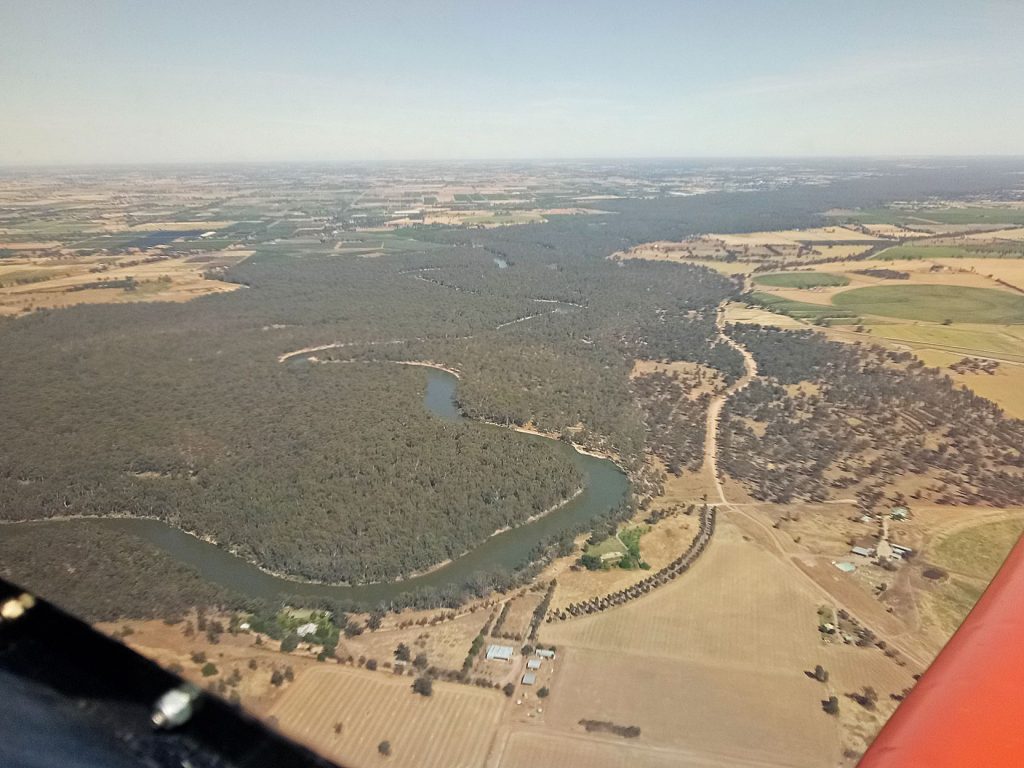
I crossed the Murray River (and NSW/Victoria border) near Yarrawonga which I mention only to justify the following ditty:
A proud guy from Yarrawonga
Impressed girls because he was much stronger
But the woman he wed
Took him down when she said
“Gosh I thought it would be a bit longer
After the parched landscape of Queensland and much of New South Wales it was good to see a bit more green in Victoria courtesy of some late winter rain.
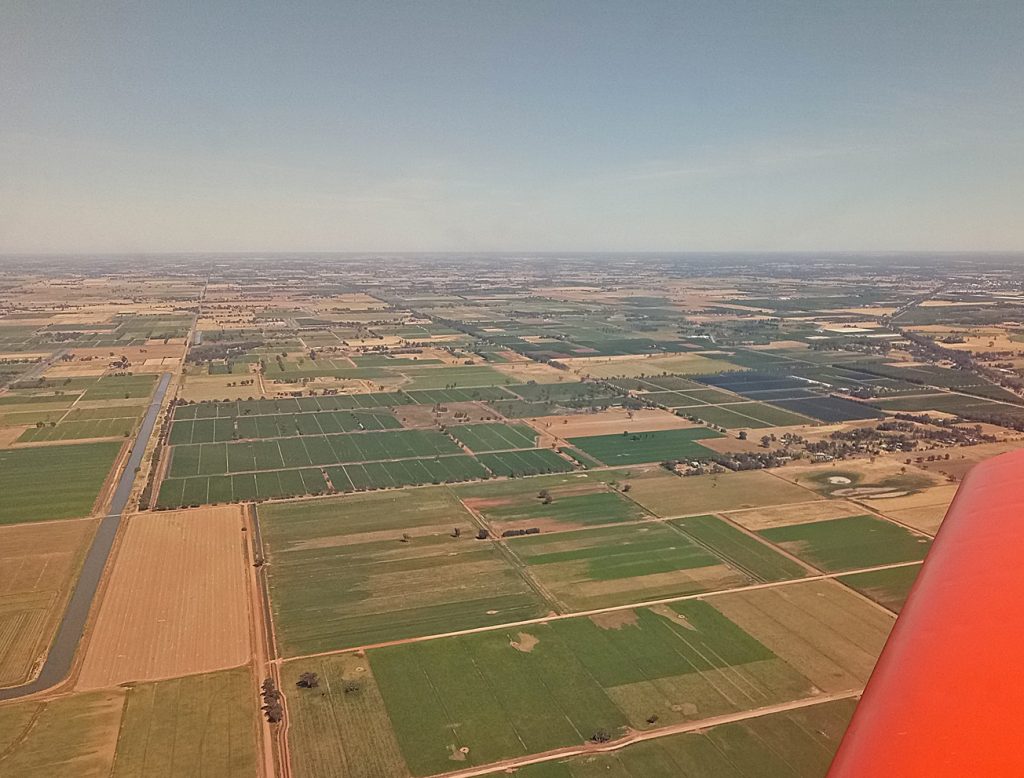
Distance Time Av. speed Fuel used Fuel rate
225 NM 1.82 hrs 124 knots 36 litres 19.78 l/hr
For the whole trip
Distance Time Av. speed Fuel used Fuel rate
1931 NM 16.9 hrs 114 knots 331.5 litres 19.62 l/hr
2222 miles 131 mph 87.6 gallons 5.18 US gal/hr
So did flying the Sonex make any sense?
Economically, the answer is no. Smaller destinations that are only serviced by regional airlines are pretty expensive places to fly but Rockhampton is serviced by the two major carriers, Qantas and Virgin Blue, and by booking a couple of weeks in advance I could have bought a return ticket for a little over $500. Even booking my flight only a couple of days in advance I still could have bought a return ticket for about $740. The cost for flying the Sonex was about $760 for fuel, $80 for a night’s accommodation and $144 for hangar rent at Headlow.
So what about the enjoyment factor? I certainly felt a sense of achievement on completing both legs of the journey and while I have enjoyed doing this trip a couple of times before, on this occasion, except for the second day on the return trip, conditions made the trip more arduous than enjoyable. On the other hand, how else would I be able to get a photograph like this?
